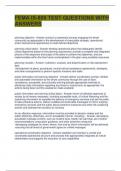FEMA IS-800 TEST QUESTIONS WITH
ANSWERS
planning objective - Answer-conduct a systematic process engaging the whole
community as appropriate in the development of executable strategic, operational,
and/or tactical-level approaches to meet defined objectives
planning critical tasks - Answer-develop operational plans that adequately identify
critical objectives based on the planning requirement, provide a complete and integrated
picture of the sequence and scope of the tasks to achieve the objectives, and are
implementable within the time frame contemplated in the plan using available resources
planning includes - Answer--collection, analysis, and dissemination of risk assessment
data
-development of plans, procedures, mutual aid and assistance agreements, strategies,
and other arrangements to perform specific missions and tasks
public information and warning objective - Answer-deliver coordinated, prompt, reliable,
and actionable information to the whole community through the use of clear,
consistence, accessible, and culturally and linguistically appropriate methods to
effectively relay information regarding any threat or hazard and, as appropriate, the
actions being taken and the assistance made available
public information and warning critical tasks - Answer-inform all affected segments of
society by all means necessary, including accessible tools, of critical lifesaving and life-
sustaining information to expedite the delivery of emergency services and aid the public
to take protective actions. Deliver credible and actionable messages to inform ongoing
emergency services and the public about protective measures and other life-sustaining
actions and facilitate the transition to recovery
for an effective response, information must be provided to decision makes and the
public efficiently, effectively, and in accessible manner, including: - Answer--developing
accessible message content, such as incident facts, health risk warnings, pre-incident
recommendations, evacuation guidance, and other protective measures
-developing strategies for when, where, how and by whom information will be delivered
-ensuring that all levels of government agree on unified messages
operational coordination objective - Answer-establish and maintain a unified and
coordinated operational structure and process that appropriately integrates all critical
stakeholders and supports the execution of core capabilities
,operational coordination critical tasks - Answer-mobilize all critical resources and
establish command, control and coordination structures within the affected community
and other coordinating bodies in surrounding communities and across the nation and
maintain as needed throughout the duration of an incident. Enhance and maintain
control, command, and coordination structures, consistent with the National Incident
Management System (NIMS), to meet basic human needs, stabilize the incident, and
transition to recover
coordination of operations must occur both among those delivering the Response core
capabilities and with those working in other mission areas. Specific actions to achieve
this core capability may include: - Answer--coordinating initial actions
-managing emergency support functions (EFSs)
-coordinating requests for additional support
-identifying and integrating resources and capabilities
lifelines = - Answer-ends (the result that responders are trying to accomplish
core capabilities = - Answer-ways (methods that the Responders will use to achieve the
ends)
coordinating structures help organize and measure the whole community's capabilities
in order to: - Answer--address the requirements of the response mission area
-facilitate problem solving
-improve access to response resources
-foster coordination prior to and following an incident
the EOC - Answer--helps form shared situational awareness of the incident
-relieves on-scene command of the burden of external coordination
-secures additional resources to help meet response requirements
Multiagency Coordination Groups (MAC Groups) - Answer--composed of senior
officials, such as agency administrators, executives, or their designees, who are
authorized to represent or commit agency resources to funds in support of incident
activities
-acts as an executive or policy-level body during incidents, supporting resource
prioritization and allocation, and enabling decision making among elected and
appointed officials and those responsible for managing the incident
-in some communities and jurisdictions, MAC groups are located at or near EOCs in
order to authorize additional resources, approve emergency authorities, and provide
guidance on emerging issues
Tribal Assistance Coordination Group (TAC-G) - Answer-a MAC Group that assists
federally recognized tribes during emergencies and disasters and provides information
and technical assistance for tribal emergency management programs in coordination
with federal partners
, Cybersecurity and Infrastructure Security Agency (CISA) Integrated Operations
Coordination Center (CIOCC) - Answer-is the focal point for federal partners, the private
sector, and local, state, tribal and territorial governments to obtain situational
awareness, technical assistance, and integrated, actionable information to secure and
defend the Nation's cyber, physical, and communications infrastructure
National Operations Center (NOC) - Answer-in the event of an act of terrorism, natural
disaster, or other emergency, the NOC, as principle operations center for the
Department of Homeland Security, coordinates and integrates information from NOC
components to provide situational awareness for the entire Federal Government, as well
as for local, tribal, and state governments, as appropriate, to ensure that accurate and
critical terrorism- and disaster- related information reaches government decision makers
in a timely manner
National Response Framework (NRF) - Answer-a guide to how the nation responds to
all types of disasters and emergencies
the national response framework (NRF) is built on - Answer-scalable, flexible, and
adaptable concepts identified in the National Incident Management System (NIMS)
the term "response" includes - Answer--actions to save lives, protect property and the
environment, stabilize the incident, and meet basic human needs following an incident
-the execution of emergency plans and actions to enable recovery
terminal objective - Answer-to describe how the national response framework is applied
to manage all-hazards response
implementation of NRF structures and procedures allows for - Answer--a scaled
response
-delivery of the specific resources and capabilities
-a level of coordination appropriate to each incident
national preparedness system (NPS) - Answer-developed to provide the approach,
resources, and tools to aid the whole community in its preparedness activities to
achieve the national preparedness goal
whats involved in the NPS? - Answer--what capabilities are needed
-how they should be developed and sustained
-how they should be delivered
National Preparedness Goal (NPG) definition - Answer-presents an integrated, layered,
and whole community approach to preparedness. The goal itself is a result of
contributions from the whole community




